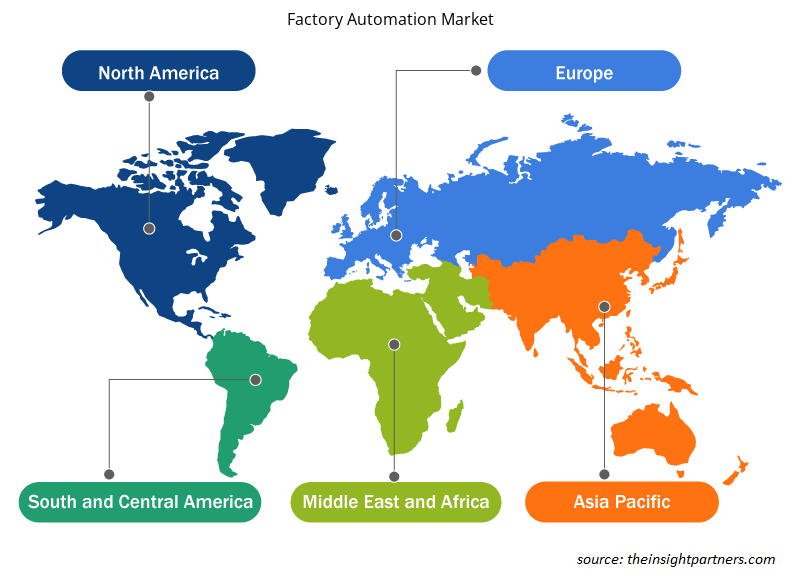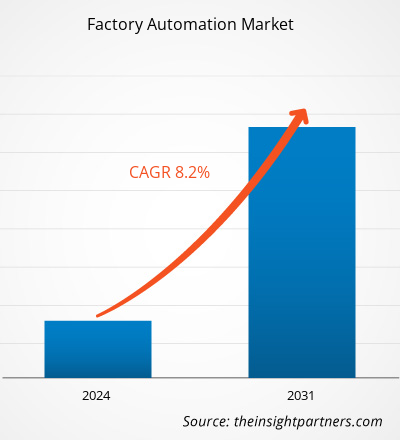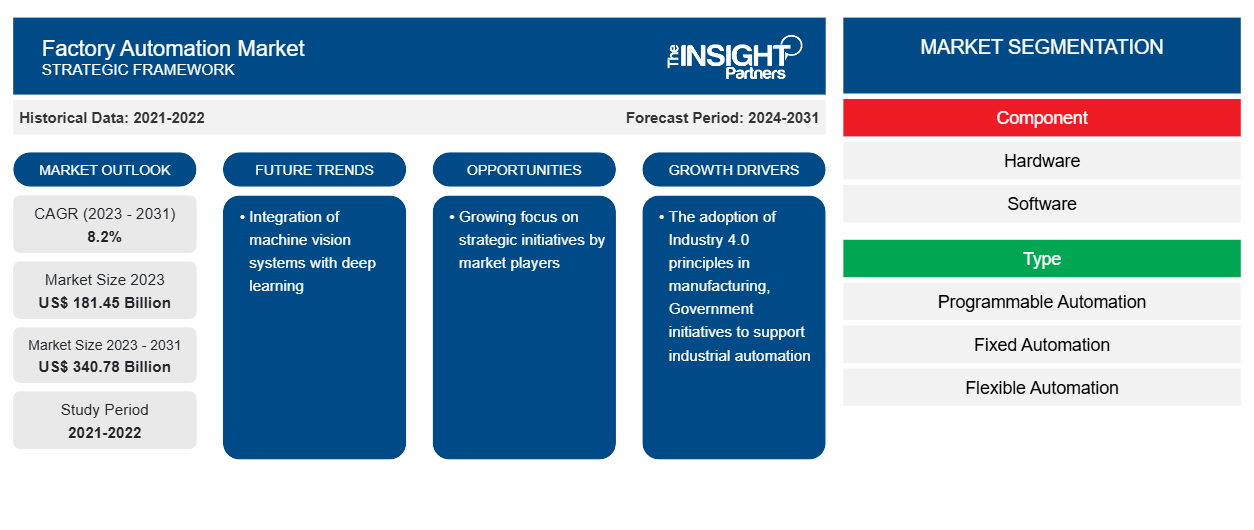Si prevede che il mercato dell'automazione di fabbrica crescerà da 181,45 miliardi di dollari nel 2023 a 340,78 miliardi di dollari entro il 2031; si prevede che si espanderà a un CAGR dell'8,2% dal 2023 al 2031. Si prevede che l'integrazione dei sistemi di visione artificiale con l'apprendimento profondo sarà una tendenza chiave nel mercato.
Analisi di mercato dell'automazione di fabbrica
Il settore manifatturiero si è espanso rapidamente nell'ultimo decennio. La globalizzazione sta espandendo il mercato, attraendo un gran numero di nuovi attori. Il vantaggio competitivo nel mercato dell'automazione di fabbrica per le aziende chiave può essere costruito attraverso la differenziazione del prodotto, la leadership di costo, il marketing mirato e un ottimo servizio post-vendita. L'automazione è un fattore critico per i processi di produzione. Inoltre, le soluzioni di automazione avanzate consentono di ottenere costantemente alta qualità, elevata produttività e bassi costi di produzione. Pertanto, si prevede che il mercato dell'automazione di fabbrica crescerà durante il periodo di previsione.
Panoramica del mercato dell'automazione di fabbrica
L'automazione di fabbrica è l'integrazione dell'automazione in tutte le fasi del processo di produzione. L'automazione nella produzione combina spesso tecnologie come sistemi pneumatici , sistemi idraulici e bracci robotici per produrre un sistema più complicato. In un ambiente competitivo, l'automazione di fabbrica può aiutare ad aumentare la produzione e l'efficienza riducendo al contempo i costi. L'automazione di fabbrica fornisce un metodo convincente per aumentare l'efficienza, la qualità, la sostenibilità, la sicurezza e la protezione in un ambiente di fabbrica moderno in rapida evoluzione.
Personalizza questo report in base alle tue esigenze
Riceverai la personalizzazione gratuita di qualsiasi report, comprese parti di questo report, o analisi a livello nazionale, pacchetto dati Excel, oltre a usufruire di grandi offerte e sconti per start-up e università
- Scopri le principali tendenze di mercato in questo rapporto.Questo campione GRATUITO includerà analisi di dati che spaziano dalle tendenze di mercato alle stime e alle previsioni.
Driver di mercato e opportunità dell'automazione di fabbrica
Adozione del principio dell'Industria 4.0 nel settore manifatturiero per favorire la crescita del mercato.
Il potere rivoluzionario della quarta rivoluzione industriale (Industria 4.0) sta modificando la produzione globale. L'Industria 4.0, che è definita (in parte) da sistemi intelligenti, intelligenza artificiale (IA), big data e architettura IT avanzata, rappresenta il passo successivo nell'evoluzione della produzione nel suo complesso e molte aziende stanno adottando queste tecnologie. I vantaggi dei processi, delle tecnologie e dei sistemi dell'Industria 4.0 includono produttività ed efficienza migliorate, maggiore agilità e flessibilità e maggiore redditività. Pertanto, si prevede che l'adozione dell'Industria 4.0 per l'automazione in numerosi settori alimenterà la crescita del mercato dell'automazione di fabbrica durante il periodo di previsione.
Crescente attenzione alle iniziative strategiche da parte degli operatori del mercato
Si prevede che la crescente attenzione dei principali partecipanti al mercato su attività strategiche come fusioni, acquisizioni e collaborazioni, tra le altre, stimolerà la crescita del mercato dell'automazione di fabbrica. Ad esempio, a luglio 2021, Rockwell Automation, Inc., impegnata nell'automazione industriale e nella trasformazione digitale, ha annunciato l'acquisizione di Plex Systems, la principale piattaforma di produzione intelligente cloud-native. Inoltre, a settembre 2021, Rockwell Automation, Inc. ha annunciato una partnership con Kezzler, una piattaforma di digitalizzazione e tracciabilità dei prodotti basata su cloud, per aiutare i produttori a catturare il percorso dei loro prodotti dalle fonti di materie prime al punto vendita o oltre utilizzando soluzioni di supply chain basate su cloud che si concentrano sulla tracciabilità dei prodotti.Plex Systems, the leading cloud-native smart manufacturing platform. Further, in September 2021, Rockwell Automation, Inc. announced a partnership with Kezzler, a cloud-based product digitization and traceability platform, to help manufacturers capture the journey of their products from raw material sources to point-of-sale or beyond using cloud-based supply chain solutions that focus on product traceability.
Analisi della segmentazione del rapporto di mercato sull'automazione di fabbrica
I segmenti chiave che hanno contribuito alla derivazione dell'analisi di mercato dell'automazione di fabbrica sono componenti, tipologia, tecnologia e settore verticale.
- In base ai componenti, il mercato si divide in hardware e software
- In base al tipo, il mercato è suddiviso in automazione programmabile, automazione fissa e automazione flessibile).
- In base alla tecnologia, il mercato è suddiviso in controllori logici programmabili (PLC), sistemi di controllo distribuito (DCS), sistemi di controllo di supervisione e acquisizione dati (SCADA), interfaccia uomo-macchina (HMI) e altri.
- In base al settore verticale, il mercato è suddiviso in automotive, alimentare e delle bevande, petrolio e gas, manifatturiero, minerario e altri.
Analisi della quota di mercato dell'automazione di fabbrica per area geografica
In base alla regione, il mercato è segmentato in Nord America, Europa, Asia Pacifico, Medio Oriente e Africa, Sud e Centro America.
Si prevede che il Nord America deterrà una quota importante del mercato dell'automazione di fabbrica durante il periodo di previsione. Questa crescita può essere attribuita all'adozione tecnologica precoce e a una forte enfasi sulle attività di ricerca e sviluppo. Inoltre, si prevede che la crescente popolarità dei robot collaborativi e delle iniziative governative per la trasformazione digitale in tutti i settori alimenterà il mercato dell'automazione di fabbrica durante il periodo di previsione.
Approfondimenti regionali sul mercato dell'automazione di fabbrica
Le tendenze regionali e i fattori che influenzano il mercato dell'automazione di fabbrica durante il periodo di previsione sono stati ampiamente spiegati dagli analisti di Insight Partners. Questa sezione discute anche i segmenti e la geografia del mercato dell'automazione di fabbrica in Nord America, Europa, Asia Pacifico, Medio Oriente e Africa e America meridionale e centrale.

- Ottieni i dati specifici regionali per il mercato dell'automazione di fabbrica
Ambito del rapporto sul mercato dell'automazione di fabbrica
| Attributo del report | Dettagli |
|---|---|
| Dimensioni del mercato nel 2023 | 181,45 miliardi di dollari USA |
| Dimensioni del mercato entro il 2031 | 340,78 miliardi di dollari USA |
| CAGR globale (2023-2031) | 8,2% |
| Dati storici | 2021-2022 |
| Periodo di previsione | 2024-2031 |
| Segmenti coperti | Per componente
|
| Regioni e Paesi coperti | America del Nord
|
| Leader di mercato e profili aziendali chiave |
|
Densità degli attori del mercato dell'automazione di fabbrica: comprendere il suo impatto sulle dinamiche aziendali
Il mercato dell'automazione di fabbrica sta crescendo rapidamente, spinto dalla crescente domanda degli utenti finali dovuta a fattori quali l'evoluzione delle preferenze dei consumatori, i progressi tecnologici e una maggiore consapevolezza dei vantaggi del prodotto. Con l'aumento della domanda, le aziende stanno ampliando le loro offerte, innovando per soddisfare le esigenze dei consumatori e capitalizzando sulle tendenze emergenti, il che alimenta ulteriormente la crescita del mercato.
La densità degli operatori di mercato si riferisce alla distribuzione di aziende o società che operano in un particolare mercato o settore. Indica quanti concorrenti (operatori di mercato) sono presenti in un dato spazio di mercato in relazione alle sue dimensioni o al valore di mercato totale.
Le principali aziende che operano nel mercato dell'automazione di fabbrica sono:
- ABB Ltd.
- Azienda Emerson Electric
- Società Fanuc
- Compagnia elettrica generale
- Mitsubishi Electric Corporation
- Honeywell International Inc.
Disclaimer : le aziende elencate sopra non sono classificate secondo un ordine particolare.

- Ottieni una panoramica dei principali attori del mercato dell'automazione di fabbrica
Notizie e sviluppi recenti del mercato dell'automazione di fabbrica
Il mercato dell'automazione di fabbrica viene valutato raccogliendo dati qualitativi e quantitativi dopo la ricerca primaria e secondaria, che include importanti pubblicazioni aziendali, dati associativi e database. Di seguito sono elencati alcuni degli sviluppi nell'automazione di fabbrica:
- Mitsubishi Electric Corporation ha annunciato che investirà circa 2,2 miliardi di rupie indiane, o 3,1 miliardi di yen, nella sua sussidiaria Mitsubishi Electric India Pvt. Ltd. per stabilire una nuova fabbrica in India. La nuova fabbrica, la cui entrata in funzione è prevista per dicembre 2023, produrrà inverter e altri prodotti per sistemi di controllo di automazione di fabbrica (FA), ampliando le capacità dell'azienda per soddisfare la crescente domanda in India. (Fonte: Mitsubishi Electric Corporation, comunicato stampa, giugno 2022)
Copertura e risultati del rapporto sul mercato dell'automazione di fabbrica
Le previsioni di mercato dell'automazione di fabbrica sono stimate in base a vari risultati di ricerche secondarie e primarie, come pubblicazioni aziendali chiave, dati di associazioni e database. Il rapporto di mercato "Dimensioni e previsioni del mercato dell'automazione di fabbrica (2021-2031)" fornisce un'analisi dettagliata del mercato che copre le seguenti aree:
- Dimensioni e previsioni del mercato dell'automazione di fabbrica a livello globale, regionale e nazionale per tutti i segmenti di mercato chiave coperti dall'ambito
- Tendenze del mercato dell'automazione di fabbrica, nonché dinamiche di mercato quali driver, vincoli e opportunità chiave
- Analisi dettagliata delle cinque forze PEST/Porter e SWOT
- Analisi di mercato dell'automazione di fabbrica che copre le principali tendenze di mercato, il quadro globale e regionale, i principali attori, le normative e i recenti sviluppi del mercato
- Analisi del panorama industriale e della concorrenza che copre la concentrazione del mercato, l'analisi della mappa di calore, i principali attori e gli sviluppi recenti nel mercato dell'automazione di fabbrica
- Profili aziendali dettagliati.
- Analisi storica (2 anni), anno base, previsione (7 anni) con CAGR
- Analisi PEST e SWOT
- Valore/volume delle dimensioni del mercato - Globale, Regionale, Nazionale
- Industria e panorama competitivo
- Set di dati Excel
Report recenti
Testimonianze
Motivo dell'acquisto
- Processo decisionale informato
- Comprensione delle dinamiche di mercato
- Analisi competitiva
- Analisi dei clienti
- Previsioni di mercato
- Mitigazione del rischio
- Pianificazione strategica
- Giustificazione degli investimenti
- Identificazione dei mercati emergenti
- Miglioramento delle strategie di marketing
- Aumento dell'efficienza operativa
- Allineamento alle tendenze normative





















 Ottieni un campione gratuito per - Mercato dell'automazione di fabbrica
Ottieni un campione gratuito per - Mercato dell'automazione di fabbrica